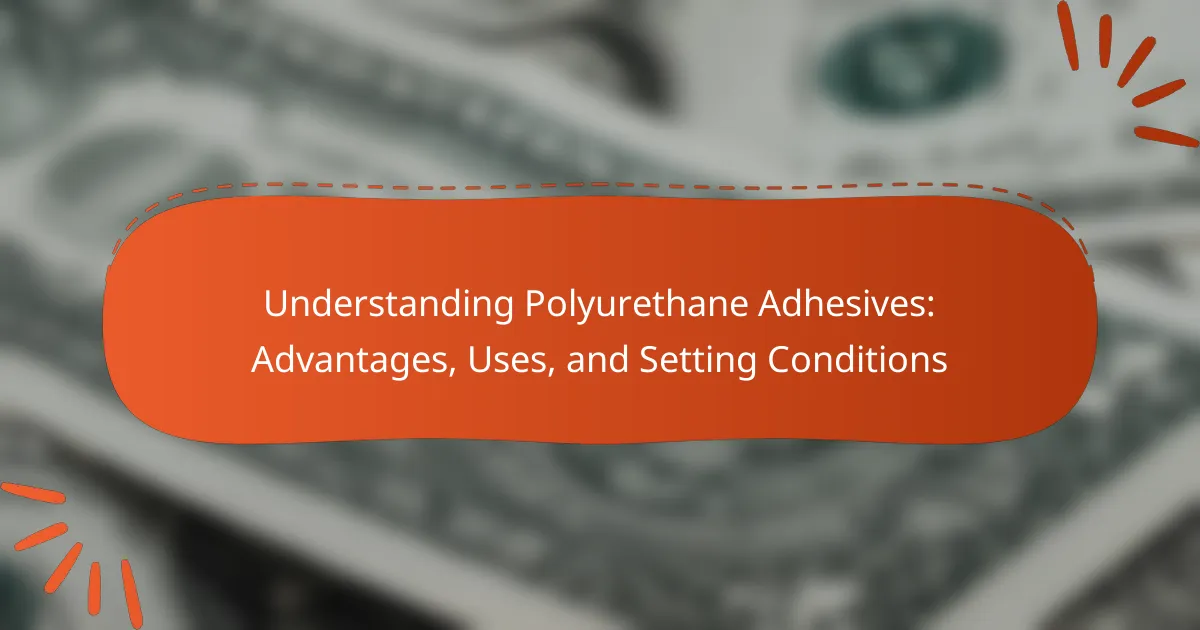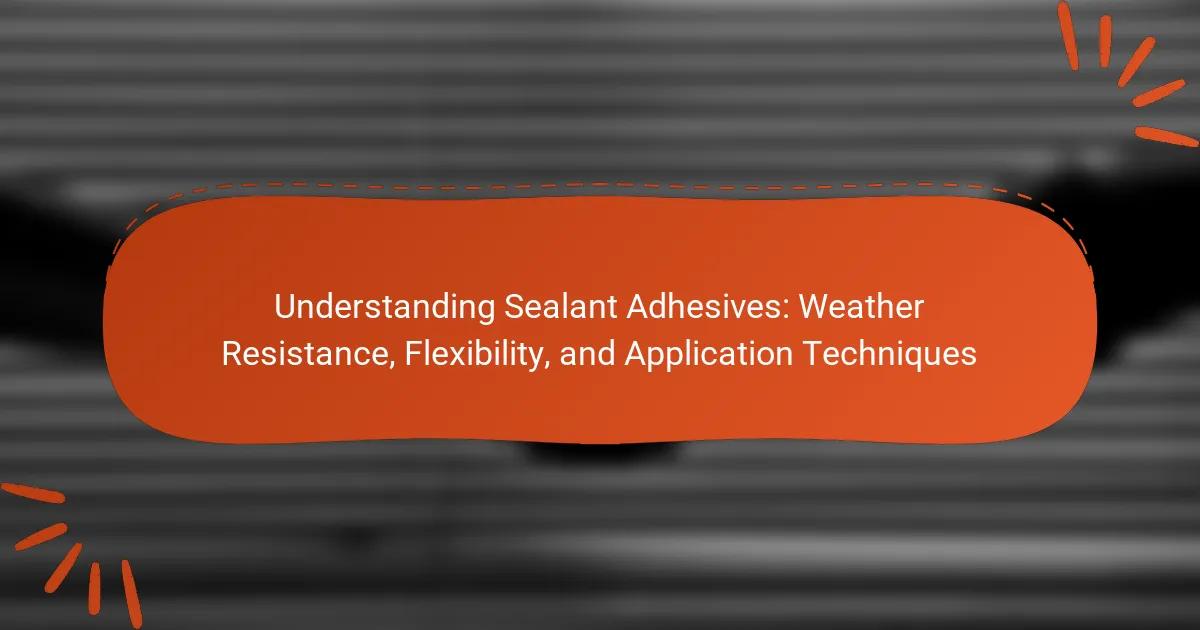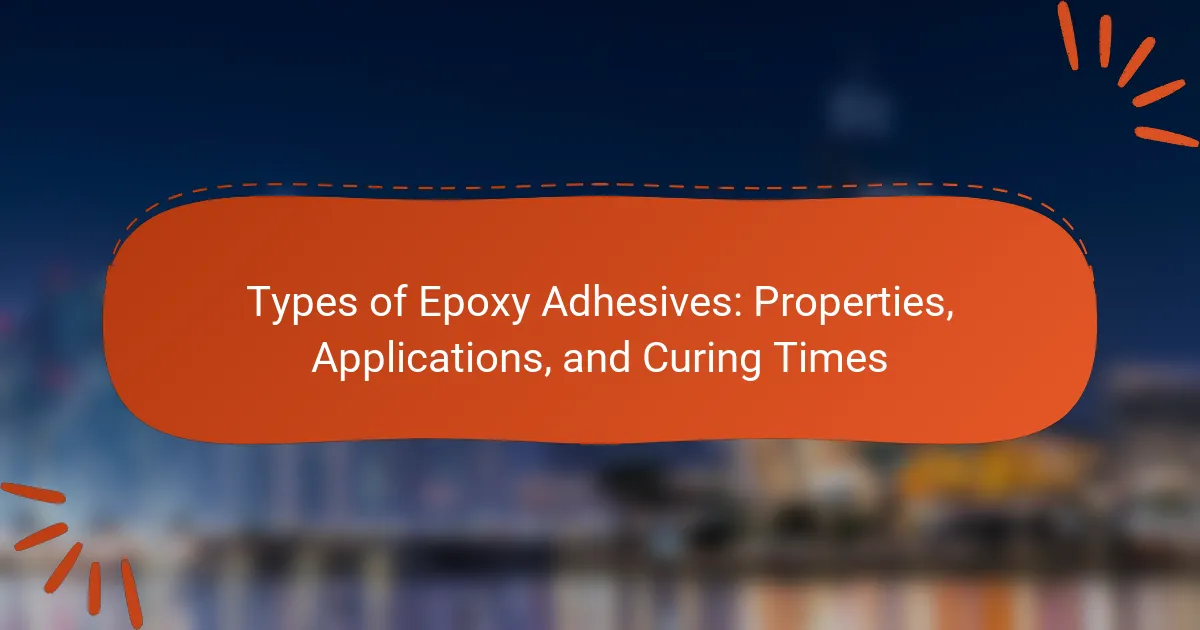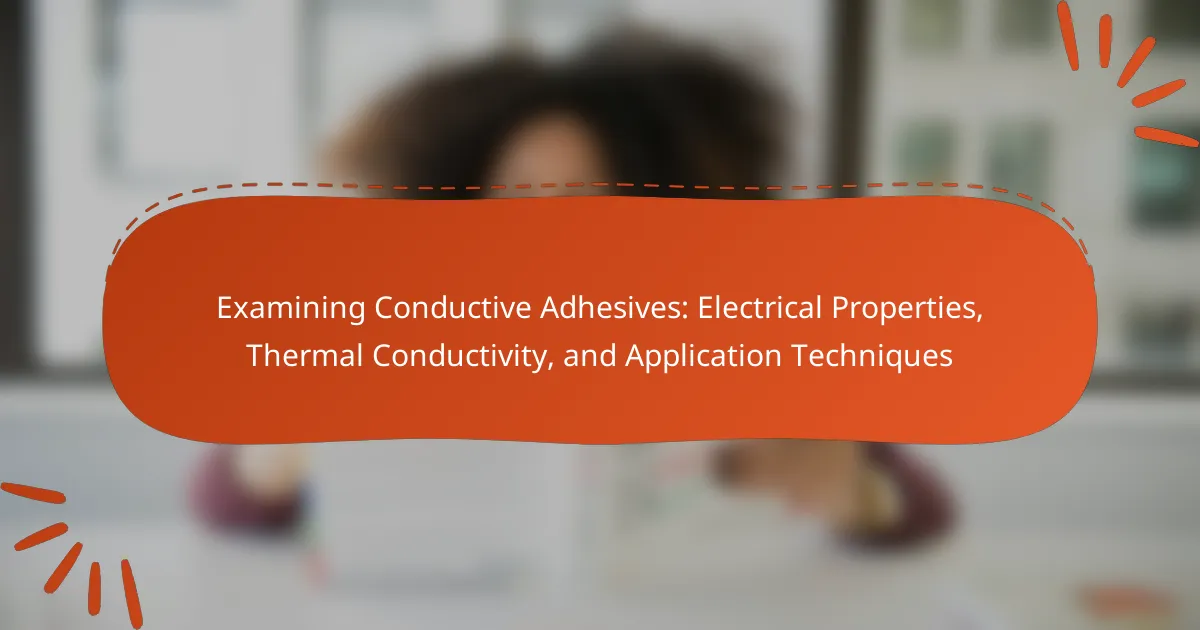Polyurethane adhesives are synthetic adhesives known for their strong bonding capabilities across various materials, including wood, metal, plastic, and ceramics. These adhesives cure through a chemical reaction between isocyanates and polyols, providing moisture resistance, flexibility, and durability. Their applications span multiple industries, such as construction, automotive, and furniture, where they are valued for their ability to bond dissimilar materials and withstand environmental conditions. The article also highlights the importance of temperature, humidity, and surface preparation on the curing process and overall adhesion quality, ensuring optimal performance in various settings.
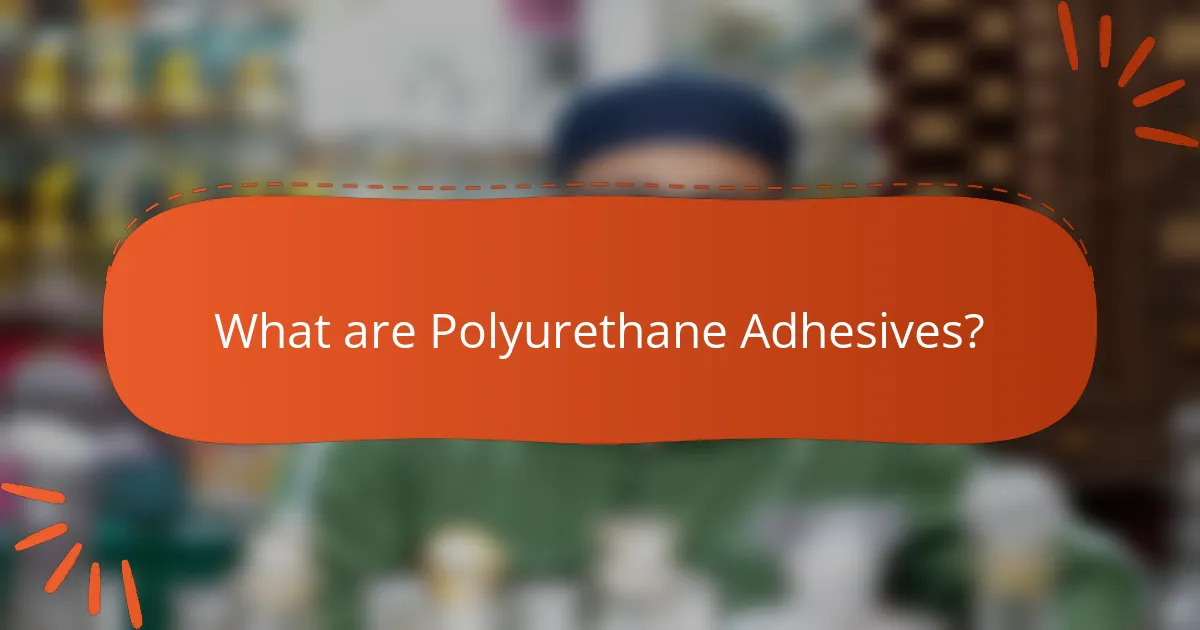
What are Polyurethane Adhesives?
Polyurethane adhesives are synthetic adhesives made from polyurethane polymers. They are known for their strong bonding capabilities across various materials. These adhesives cure through a chemical reaction between isocyanates and polyols. They can bond wood, metal, plastic, and ceramics effectively. Polyurethane adhesives are also moisture-resistant and flexible. Their versatility makes them suitable for construction, automotive, and furniture industries. The strength of polyurethane adhesives is often superior to other adhesive types. They can withstand temperature fluctuations and environmental conditions.
How do Polyurethane Adhesives differ from other types of adhesives?
Polyurethane adhesives differ from other types of adhesives in their versatility and bonding strength. They can bond a wide range of materials, including wood, metal, and plastics. Polyurethane adhesives are moisture-curing, meaning they can cure in humid environments. This property allows them to be used effectively in outdoor applications. Additionally, they offer excellent flexibility and resistance to impact and vibration. Unlike some other adhesives, polyurethane adhesives can also fill gaps in joint surfaces. Their chemical structure enables them to provide superior durability over time. This makes them ideal for applications requiring long-lasting bonds.
What are the unique properties of Polyurethane Adhesives?
Polyurethane adhesives possess unique properties that set them apart from other adhesive types. They exhibit excellent flexibility, allowing for movement without cracking. Their strong bonding capability adheres well to a variety of substrates, including wood, metal, and plastics. Polyurethane adhesives are also resistant to moisture and chemicals, making them suitable for outdoor use. They can cure at room temperature, which simplifies application. Additionally, these adhesives have good gap-filling properties, accommodating uneven surfaces. Their durability ensures long-lasting bonds under stress. These characteristics make polyurethane adhesives versatile for various industrial and construction applications.
How do the chemical structures of Polyurethane Adhesives influence their performance?
The chemical structures of polyurethane adhesives significantly influence their performance. Polyurethane adhesives consist of isocyanate and polyol components. This combination allows for a versatile range of properties. The ratio of these components affects the adhesive’s strength and flexibility.
Higher isocyanate content generally increases hardness and strength. Conversely, higher polyol content enhances flexibility and elongation. The molecular weight of the polyol also impacts the viscosity and curing speed. A lower molecular weight can lead to faster curing times.
The presence of additives, such as fillers or plasticizers, can further modify performance characteristics. These modifications can improve adhesion to various substrates. They can also enhance resistance to environmental factors like moisture and temperature.
Research shows that the specific arrangement of functional groups in the structure affects bonding mechanisms. This includes hydrogen bonding and van der Waals forces, which are crucial for adhesion. Therefore, the chemical structure directly correlates with the adhesive’s overall effectiveness in applications.
What are the main components of Polyurethane Adhesives?
The main components of polyurethane adhesives are polyols and isocyanates. Polyols are the main building blocks that provide flexibility and durability. Isocyanates react with polyols to form the adhesive’s structure. These components undergo a chemical reaction to create a strong bond. The ratio of polyols to isocyanates affects the adhesive’s properties. Additional additives may include catalysts and fillers to enhance performance. These components work together to ensure adhesion to various materials.
What role do polyols play in Polyurethane Adhesives?
Polyols are essential components in polyurethane adhesives. They react with isocyanates to form the polymer matrix. This reaction leads to the development of the adhesive’s structure and properties. Polyols contribute to flexibility and toughness in the final product. Different types of polyols can modify the adhesive’s characteristics. For example, polyether polyols enhance moisture resistance. Polyester polyols can improve adhesion to substrates. The choice of polyol affects the adhesive’s performance in various applications. Overall, polyols play a crucial role in determining the functionality of polyurethane adhesives.
How do isocyanates contribute to the effectiveness of Polyurethane Adhesives?
Isocyanates are crucial components in the formulation of polyurethane adhesives. They react with polyols to create a polymer network that enhances adhesion properties. This reaction leads to the formation of flexible and durable bonds. The presence of isocyanates improves the adhesive’s resistance to moisture and temperature variations. Research shows that adhesives with higher isocyanate content exhibit greater tensile strength. This strength is vital for applications in construction and automotive industries. Furthermore, isocyanates contribute to the rapid curing process of polyurethane adhesives. This quick setting time is advantageous in various manufacturing processes. Overall, isocyanates significantly enhance the performance and versatility of polyurethane adhesives.
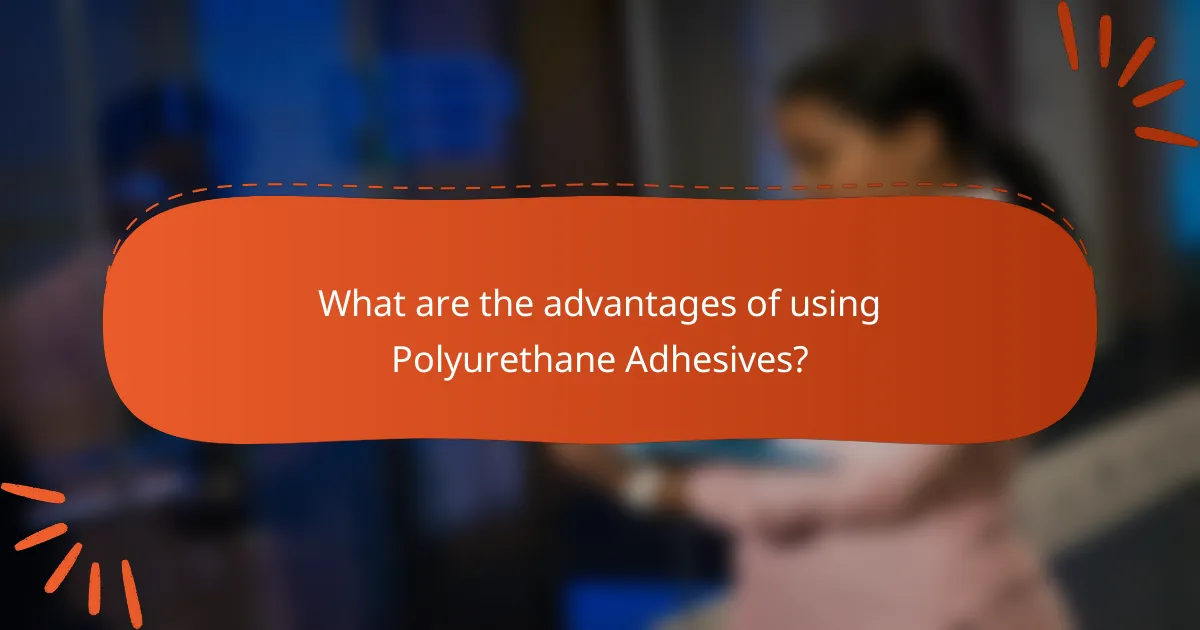
What are the advantages of using Polyurethane Adhesives?
Polyurethane adhesives offer strong bonding capabilities across various materials. They provide excellent flexibility, which allows for movement without compromising the bond. These adhesives are resistant to moisture, heat, and chemicals, enhancing durability. They can bond dissimilar materials, making them versatile for numerous applications. Polyurethane adhesives also cure quickly, allowing for faster project completion. Their ability to fill gaps ensures a secure bond even on uneven surfaces. According to industry standards, polyurethane adhesives maintain strength over time, which contributes to long-lasting results.
Why are Polyurethane Adhesives considered versatile?
Polyurethane adhesives are considered versatile due to their ability to bond a wide range of materials. They can effectively adhere to wood, metal, plastic, and ceramics. This broad compatibility allows them to be used in various applications. Polyurethane adhesives also provide strong, flexible bonds that can withstand environmental changes. They exhibit resistance to moisture, chemicals, and temperature fluctuations. These properties make them suitable for both indoor and outdoor use. Additionally, they can be formulated for specific needs, enhancing their adaptability. The versatility of polyurethane adhesives is further demonstrated by their use in construction, automotive, and consumer products.
What specific applications benefit from the versatility of Polyurethane Adhesives?
Polyurethane adhesives benefit various applications due to their strong bonding capabilities and flexibility. They are widely used in the automotive industry for assembling components and interior fixtures. In construction, these adhesives bond materials like wood, metal, and concrete. They are also effective in the manufacturing of furniture, providing durable joints. Additionally, polyurethane adhesives are used in the footwear industry for attaching soles to uppers. Their versatility extends to electronic devices, where they secure components and enhance durability. These adhesives perform well in both indoor and outdoor applications, resisting moisture and temperature changes. Their ability to bond dissimilar materials makes them ideal for diverse industries.
How do Polyurethane Adhesives provide superior bonding strength?
Polyurethane adhesives provide superior bonding strength due to their unique chemical composition and flexibility. They consist of a polymer that cures through a reaction with moisture in the air. This curing process forms strong, durable bonds with various substrates, including wood, metal, and plastics.
The adhesive’s flexibility allows it to absorb stress and movement without cracking. This characteristic is particularly beneficial in applications where materials may expand or contract. Polyurethane adhesives also have excellent resistance to environmental factors such as moisture, heat, and chemicals.
Research indicates that polyurethane adhesives can achieve tensile strengths exceeding 4000 psi, making them suitable for demanding applications. Their ability to bond dissimilar materials further enhances their utility in construction and manufacturing.
What are the environmental benefits of using Polyurethane Adhesives?
Polyurethane adhesives offer several environmental benefits. They are often formulated with low volatile organic compounds (VOCs). This reduces air pollution and improves indoor air quality. Polyurethane adhesives also exhibit strong bonding capabilities. This allows for the use of less adhesive material in applications. Consequently, this can lead to reduced waste. Furthermore, many polyurethane adhesives are derived from renewable resources. This contributes to sustainability in manufacturing processes. Their durability extends the lifespan of bonded products. This reduces the need for frequent replacements and minimizes environmental impact.
How do Polyurethane Adhesives compare in sustainability to other adhesive types?
Polyurethane adhesives are generally less sustainable compared to some other adhesive types. They often contain isocyanates, which can be harmful to the environment and human health. In contrast, natural adhesives like starch or casein are derived from renewable resources. These alternatives typically have a lower carbon footprint and are biodegradable. Additionally, some synthetic adhesives, such as those based on water, have reduced volatile organic compounds (VOCs). This makes them more environmentally friendly. Studies have shown that the production of polyurethane adhesives can result in significant emissions. Therefore, while polyurethane adhesives offer strong bonding capabilities, their environmental impact is a notable drawback compared to more sustainable options.
What innovations in Polyurethane Adhesives promote eco-friendliness?
Innovations in polyurethane adhesives that promote eco-friendliness include the development of bio-based formulations. These formulations utilize renewable resources, reducing reliance on fossil fuels. Additionally, advancements in low-VOC (volatile organic compounds) technologies minimize harmful emissions during application. Water-based polyurethane adhesives also contribute to eco-friendliness by reducing solvent usage. Enhanced durability and bonding strength in new formulations lead to longer-lasting products, which decreases waste. Research indicates that these innovations significantly lower the environmental impact of adhesive applications. For instance, studies show that bio-based adhesives can reduce carbon footprints by up to 30%.
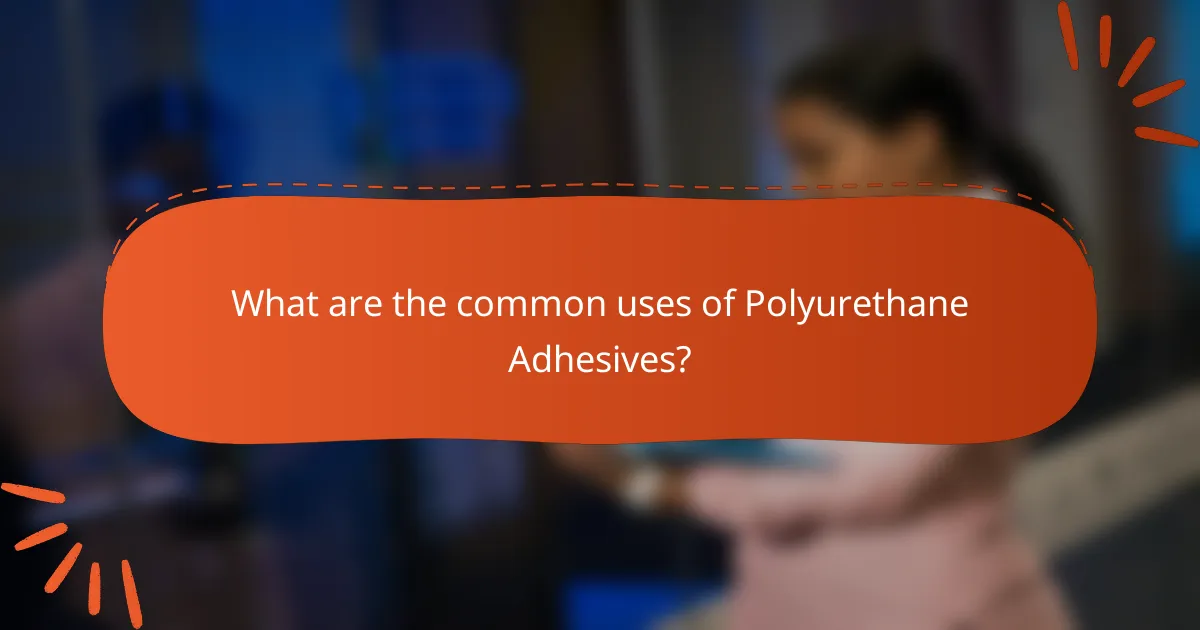
What are the common uses of Polyurethane Adhesives?
Polyurethane adhesives are commonly used for bonding a variety of materials. They effectively bond wood, metal, plastic, and glass. These adhesives are popular in construction for joining flooring and roofing materials. They are also utilized in automotive applications for attaching trim and components. In the furniture industry, polyurethane adhesives secure joints and laminates. Additionally, they are used in crafts and DIY projects for their strong and flexible bond. Their resistance to moisture makes them ideal for outdoor applications.
In which industries are Polyurethane Adhesives predominantly used?
Polyurethane adhesives are predominantly used in the automotive, construction, furniture, and footwear industries. In the automotive sector, these adhesives bond various materials, including metals and plastics. The construction industry utilizes them for sealing and bonding applications in building materials. In furniture manufacturing, polyurethane adhesives provide strong bonds for wood and composite materials. The footwear industry benefits from their flexibility and durability in attaching different components. These industries rely on the unique properties of polyurethane adhesives for their performance and versatility.
What specific applications within construction utilize Polyurethane Adhesives?
Polyurethane adhesives are utilized in various specific applications within construction. They are commonly used for bonding wood, metal, and concrete. These adhesives excel in applications such as flooring installation, where strong adhesion is crucial. They are also employed in the assembly of windows and doors, providing durability against weather conditions. Additionally, polyurethane adhesives are effective in roofing systems, ensuring waterproof seals. Their flexibility makes them suitable for construction projects that require movement accommodation. These adhesives are often used in the manufacture of composite materials, enhancing structural integrity. Their resistance to chemicals further broadens their application in construction environments.
How are Polyurethane Adhesives applied in automotive manufacturing?
Polyurethane adhesives are applied in automotive manufacturing through various methods including spraying, brushing, and extrusion. These adhesives bond materials such as metal, plastic, and glass. The application process often involves surface preparation to ensure optimal adhesion. Surfaces must be cleaned and sometimes primed before adhesive application. After application, curing occurs, which can be accelerated through heat. The curing process is critical for achieving the desired strength and durability. Research indicates that polyurethane adhesives provide excellent resistance to environmental factors like moisture and temperature fluctuations. This makes them ideal for automotive applications where durability is essential.
How can Polyurethane Adhesives be effectively utilized in everyday projects?
Polyurethane adhesives can be effectively utilized in everyday projects by providing strong, durable bonds across various materials. They are ideal for woodworking, as they expand during curing to fill gaps and create a robust bond. These adhesives work well on porous surfaces like wood and concrete, ensuring a solid grip. Additionally, they are water-resistant, making them suitable for outdoor applications. When using polyurethane adhesives, it is essential to follow the manufacturer’s instructions for optimal results. This includes proper surface preparation, such as cleaning and sanding, to enhance adhesion. They can also bond dissimilar materials, such as metal to plastic, which adds versatility to their use.
What tips are essential for applying Polyurethane Adhesives successfully?
Ensure surfaces are clean and dry before application. Contaminants can hinder adhesion effectiveness. Apply polyurethane adhesive in a well-ventilated area. This prevents inhalation of fumes and improves curing. Use the adhesive within its specified temperature range. Optimal temperatures enhance bonding strength. Clamp or secure the materials together during curing. This maintains contact for better adhesion. Allow adequate curing time as per manufacturer instructions. Insufficient time can lead to weak bonds. Store adhesive properly to maintain its efficacy. Follow storage guidelines to prolong shelf life.
What common mistakes should be avoided when using Polyurethane Adhesives?
Common mistakes to avoid when using polyurethane adhesives include improper surface preparation. Surfaces should be clean, dry, and free of contaminants. Failing to follow this can lead to weak bonds. Another mistake is not applying the adhesive evenly. Uneven application can cause insufficient adhesion. Users often ignore the recommended curing time. Rushing this process can compromise the bond strength. Additionally, not using the correct type of polyurethane adhesive for the material can lead to failures. Lastly, avoiding proper safety measures, such as using gloves and working in a ventilated area, can pose health risks.
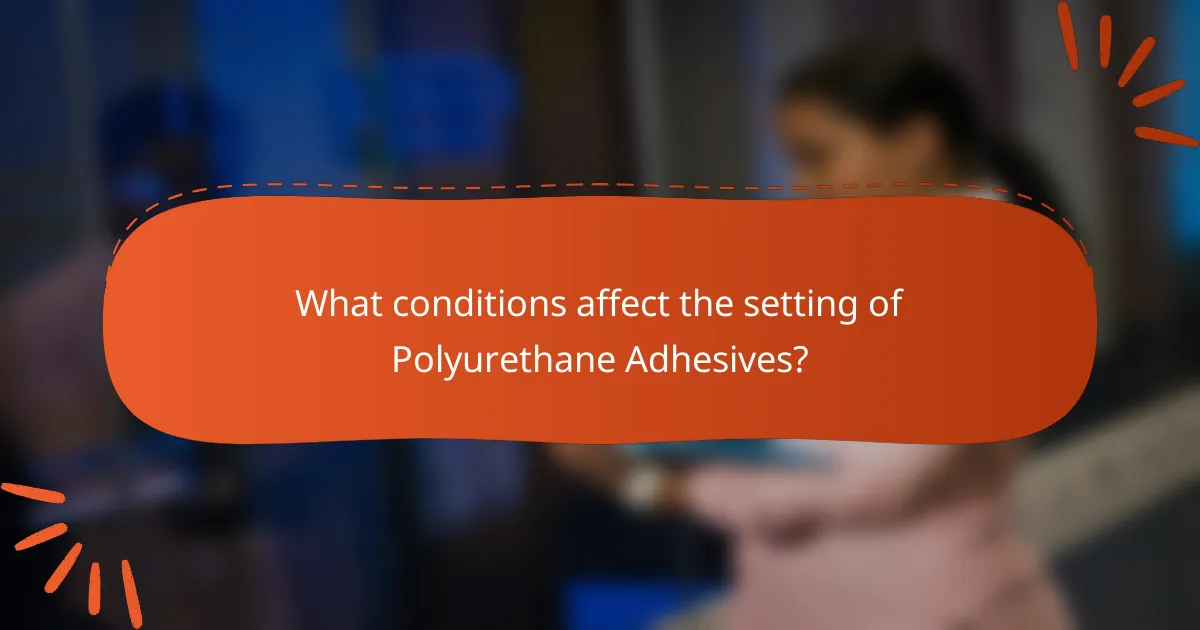
What conditions affect the setting of Polyurethane Adhesives?
Temperature significantly affects the setting of polyurethane adhesives. Higher temperatures generally accelerate the curing process. Conversely, lower temperatures can slow down or even inhibit setting. Humidity levels also play a crucial role in the curing process. Increased humidity can enhance the reaction between components, while low humidity may hinder it. Surface preparation impacts adhesion quality and setting time. Clean, dry surfaces promote better bonding and faster curing. The ratio of resin to hardener is critical; incorrect ratios can lead to incomplete curing. Lastly, the presence of contaminants can negatively affect adhesion and setting efficiency.
How do temperature and humidity influence the curing process?
Temperature and humidity significantly influence the curing process of polyurethane adhesives. Higher temperatures typically accelerate the curing reaction. This results in faster setting times and potentially stronger bonds. Conversely, low temperatures can slow down the curing, leading to extended setting times. Humidity also plays a crucial role. Increased humidity can enhance the curing process by providing moisture necessary for certain polyurethane formulations. However, excessively high humidity may lead to issues such as foaming or improper adhesion. Optimal curing conditions generally range from 20°C to 30°C with moderate humidity levels. Studies show that maintaining these conditions improves overall adhesive performance and bond strength.
What are the ideal environmental conditions for optimal curing?
The ideal environmental conditions for optimal curing of polyurethane adhesives are a temperature range of 20 to 30 degrees Celsius and humidity levels between 40% to 60%. This temperature range allows for proper chemical reactions necessary for curing. Humidity levels within this range help to prevent premature curing and ensure proper adhesion. Research indicates that lower temperatures can slow down the curing process, while higher temperatures may lead to rapid curing and reduced bond strength. Maintaining these conditions enhances the performance and durability of the adhesive.
How can variations in conditions affect the adhesive’s performance?
Variations in conditions can significantly affect the performance of adhesives. Temperature influences the curing process of polyurethane adhesives. High temperatures can accelerate curing, while low temperatures may slow it down. Humidity also plays a critical role; excessive moisture can weaken the bond. Surface cleanliness is essential; contaminants can hinder adhesion. The substrate material affects how well the adhesive bonds. Different materials may require specific surface treatments for optimal performance. Additionally, the presence of chemicals can degrade adhesive properties. Studies show that optimal conditions enhance bond strength and durability.
What are the best practices for ensuring proper setting of Polyurethane Adhesives?
Ensure proper setting of polyurethane adhesives by following key best practices. First, clean the surfaces to be bonded thoroughly. Remove dust, grease, and moisture for optimal adhesion. Next, apply the adhesive evenly to both surfaces. Use a consistent thickness to avoid weak spots. Clamp the surfaces together firmly during the curing process. This ensures maximum contact and strength. Maintain the recommended temperature and humidity levels for the adhesive. Most polyurethane adhesives require a temperature range of 60°F to 100°F. Allow sufficient curing time as specified by the manufacturer. Full strength may take up to 24 hours or more. Lastly, avoid disturbing the bond during the initial setting phase. This prevents misalignment and weak adhesion.
What preparation steps should be taken before applying Polyurethane Adhesives?
Clean the surfaces to be bonded thoroughly. Remove dust, grease, and contaminants. Use a suitable solvent for cleaning, such as isopropyl alcohol. Ensure the surfaces are dry before applying the adhesive. Check for compatibility of materials to be bonded. Test a small area if uncertain. Gather necessary tools and materials for application. Follow the manufacturer’s instructions for specific preparation requirements.
How can one troubleshoot common setting issues with Polyurethane Adhesives?
To troubleshoot common setting issues with polyurethane adhesives, check the temperature and humidity conditions. Polyurethane adhesives require a minimum temperature of 50°F (10°C) to cure properly. High humidity can also affect curing time. Ensure the adhesive is mixed thoroughly according to the manufacturer’s instructions. Inadequate mixing can lead to improper setting. Verify that the surfaces to be bonded are clean and free of contaminants. Dust, oil, or moisture can hinder adhesion. If the adhesive is not setting, consider increasing the ambient temperature or using a heat source. Additionally, check the adhesive’s shelf life; expired products may not perform effectively.
Polyurethane adhesives are synthetic adhesives derived from polyurethane polymers, known for their strong bonding capabilities across various materials such as wood, metal, plastic, and ceramics. This article explores the unique properties, advantages, and versatility of polyurethane adhesives, highlighting their applications in industries like construction, automotive, and furniture. Additionally, it examines the chemical components of these adhesives—polyols and isocyanates—and their influence on performance, as well as the ideal conditions for effective setting and common troubleshooting methods. The discussion emphasizes the environmental benefits and innovations in polyurethane adhesives, providing a comprehensive understanding of their role in modern manufacturing and construction processes.
